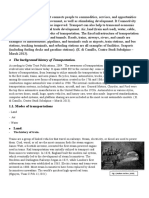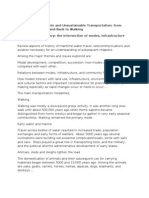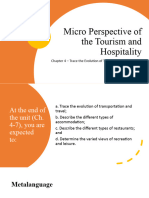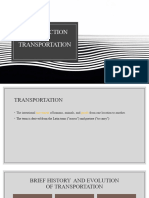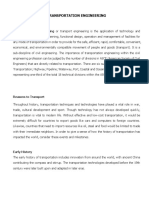Evolution of Transportation
Evolution of Transportation
Uploaded by
shirobaka98Copyright:
Available Formats
Evolution of Transportation
Evolution of Transportation
Uploaded by
shirobaka98Original Title
Copyright
Available Formats
Share this document
Did you find this document useful?
Is this content inappropriate?
Copyright:
Available Formats
Evolution of Transportation
Evolution of Transportation
Uploaded by
shirobaka98Copyright:
Available Formats
The Evolution of Transportation
Introduction:
Transportation has been a crucial aspect of human civilization, shaping economies, cultures, and
societies. From ancient times to the modern era, the methods and means of transportation have
undergone significant transformations, improving connectivity and accessibility.
1. Early Forms of Transportation:
In ancient times, human and animal power were the primary means of transportation. People
traveled on foot or used domesticated animals such as horses, donkeys, and camels for carrying
goods and passengers. The invention of the wheel around 3500 BCE in Mesopotamia revolutionized
land transport, leading to the development of carts and chariots.
2. Maritime Advancements:
Seafaring was an essential mode of transportation for trade and exploration. Ancient civilizations,
such as the Egyptians, Greeks, and Phoenicians, built ships to navigate rivers and seas. The
development of larger and more durable ships facilitated long-distance trade and cultural exchanges
across regions.
3. The Age of Exploration:
The 15th and 16th centuries marked the Age of Exploration, driven by advances in navigation and
shipbuilding. Explorers like Christopher Columbus, Vasco da Gama, and Ferdinand Magellan
embarked on voyages that connected continents and led to the exchange of goods, ideas, and
cultures on a global scale.
4. The Industrial Revolution:
The Industrial Revolution in the 18th and 19th centuries brought about significant advancements in
transportation. The invention of the steam engine by James Watt led to the development of
steamships and locomotives, revolutionizing land and sea travel. Railways expanded rapidly,
connecting cities and fostering economic growth.
5. The Automobile Era:
The late 19th and early 20th centuries saw the rise of the automobile. Innovators like Karl Benz and
Henry Ford played pivotal roles in making cars accessible to the masses. The widespread adoption
of automobiles transformed urban and rural landscapes, leading to the development of roads,
highways, and suburbs.
6. Aviation and Space Travel:
The 20th century witnessed the advent of aviation, with the Wright brothers' first successful flight in
1903. Air travel became increasingly popular, shrinking distances and making global travel more
accessible. In the latter half of the century, space exploration emerged, with milestones like the
moon landing in 1969, opening new frontiers for human exploration.
7. Future Trends in Transportation:
The future of transportation is being shaped by technological advancements and sustainability
concerns. Electric vehicles (EVs) are becoming more prevalent, reducing reliance on fossil fuels.
Autonomous vehicles (AVs) promise to revolutionize road travel by enhancing safety and efficiency.
Hyperloop technology and advancements in aerospace engineering hint at faster and more efficient
long-distance travel. Additionally, sustainable transportation options, such as cycling and public
transit, are gaining importance in urban planning.
Conclusion:
Transportation has evolved remarkably over the centuries, from basic human-powered methods to
sophisticated modern systems. As technology continues to advance, the future of transportation
holds exciting possibilities that will further enhance connectivity, accessibility, and sustainability.
You might also like
- Definition of TransportationDocument4 pagesDefinition of TransportationMohamed Adel Hessin DarwishNo ratings yet
- The History of TransportationDocument3 pagesThe History of TransportationDiana FaicanNo ratings yet
- Wells Fargo Everyday Checking: Important Account InformationDocument4 pagesWells Fargo Everyday Checking: Important Account InformationLoai100% (1)
- TransportationDocument6 pagesTransportationmohammadzaki mortazaviNo ratings yet
- The Evolution of Transportation TechnologyDocument1 pageThe Evolution of Transportation Technologymynamejeffwry1No ratings yet
- Chapter 3Document4 pagesChapter 3doceliusNo ratings yet
- 18th Century To Modern Day TransportationDocument6 pages18th Century To Modern Day Transportationvanferguson2000No ratings yet
- Transport Planning Chapter One .IntroductionDocument30 pagesTransport Planning Chapter One .IntroductionEric KipkemoiNo ratings yet
- Transpo Course 1 Transportation Planing and Engineering Chapter 1-4Document126 pagesTranspo Course 1 Transportation Planing and Engineering Chapter 1-4Ysabelle TagarumaNo ratings yet
- Evolution of Means of TransportationDocument9 pagesEvolution of Means of TransportationScribdTranslationsNo ratings yet
- History of TransportDocument3 pagesHistory of Transportaboosh1699No ratings yet
- G8 IndustrialDocument10 pagesG8 IndustrialJazz MineNo ratings yet
- History of TourismDocument3 pagesHistory of Tourismrhona rabinoNo ratings yet
- Homeread (1) TransportDocument11 pagesHomeread (1) TransportTrading TradingNo ratings yet
- History of TransportDocument8 pagesHistory of TransportCristian Paulo HularNo ratings yet
- Transport: Transport or Transportation Is The Movement of Humans, Animals andDocument13 pagesTransport: Transport or Transportation Is The Movement of Humans, Animals andsiswoutNo ratings yet
- Evolution of Transportation in The World 2Document5 pagesEvolution of Transportation in The World 2thanosnose2005No ratings yet
- Class 7 TransportDocument12 pagesClass 7 TransportAAVANINo ratings yet
- Timeline of The History of TransportationDocument6 pagesTimeline of The History of TransportationJoseMelarte GoocoJr.No ratings yet
- Smart Transport of Karachi, PakistanDocument50 pagesSmart Transport of Karachi, PakistanallianztradingNo ratings yet
- Intro TranspoDocument10 pagesIntro TranspoChristian CorpuzNo ratings yet
- Timeline of The History of TransportationDocument4 pagesTimeline of The History of TransportationMagtabog NicoleNo ratings yet
- Transport - GPDocument22 pagesTransport - GPevelynna andrewNo ratings yet
- Ilovepdf Merged 9Document174 pagesIlovepdf Merged 9jennelpahilaNo ratings yet
- Ch. 4 - Micro Perspective of The Tourism and HospitalityDocument20 pagesCh. 4 - Micro Perspective of The Tourism and HospitalityFrancine BalansagNo ratings yet
- The Revolutions in The Means of TransporDocument13 pagesThe Revolutions in The Means of Transporabhay.mathurNo ratings yet
- Chapter 1 TransportationDocument27 pagesChapter 1 TransportationAldous BenedictusNo ratings yet
- Micro - TranspoDocument6 pagesMicro - Transpograce.gonzagaNo ratings yet
- Transport TechnologiesDocument16 pagesTransport TechnologiesEricNo ratings yet
- Historical Development of Transportation Mobility and Social, Technological, and Environmental ChangesDocument12 pagesHistorical Development of Transportation Mobility and Social, Technological, and Environmental Changesliezyl MantaringNo ratings yet
- MpthfinalDocument21 pagesMpthfinalavbusalpa0169cabNo ratings yet
- History of Tourism in AfricaDocument3 pagesHistory of Tourism in Africa21562172No ratings yet
- Introduction To Transportation EngineeringDocument15 pagesIntroduction To Transportation EngineeringMarlou Salazar SabanganNo ratings yet
- Tourism - Preindustrial EraDocument152 pagesTourism - Preindustrial ErabhowalchitralekhaNo ratings yet
- CH 7 - International TransportDocument61 pagesCH 7 - International TransportJustin NatanaelNo ratings yet
- History of Transportation Planning Since Ancient Age Till2Document16 pagesHistory of Transportation Planning Since Ancient Age Till2YogaLakshmiBaskaran100% (1)
- Open House Presentation On Industrial RevolutionDocument4 pagesOpen House Presentation On Industrial Revolutiontrailblazerseduconsult2019No ratings yet
- Unesco - Eolss Sample Chapters: Historical Transportation DevelopmentDocument13 pagesUnesco - Eolss Sample Chapters: Historical Transportation Developmentsenzorq123No ratings yet
- TRANSPODocument7 pagesTRANSPOvelascojhela393No ratings yet
- Assignment 1 - Andaya - HREDocument7 pagesAssignment 1 - Andaya - HREdariel.andayaNo ratings yet
- THE WHEEL Is of-WPS OfficeDocument3 pagesTHE WHEEL Is of-WPS OfficeAries BordonadaNo ratings yet
- Introduction To Transportation Planning and Engineering PDFDocument30 pagesIntroduction To Transportation Planning and Engineering PDFJohn Russel MoralesNo ratings yet
- Transport - WikipediaDocument77 pagesTransport - WikipediaTopNo ratings yet
- The Profession of TransportationDocument11 pagesThe Profession of Transportationrueenabs0% (1)
- (Yañgo) The History of TransportationDocument2 pages(Yañgo) The History of TransportationMaria Rafaella P. DadoNo ratings yet
- MICRO CHAP 4 Transpo SectorDocument107 pagesMICRO CHAP 4 Transpo Sectorpatriciarosales1019No ratings yet
- Brief Hystory of TransportDocument5 pagesBrief Hystory of Transportsenzorq123No ratings yet
- EphremDocument5 pagesEphremEphrem NigatuNo ratings yet
- Contemporary WorldDocument2 pagesContemporary Worldphiateves.21No ratings yet
- The History and Development of TourismDocument3 pagesThe History and Development of TourismSára NovakNo ratings yet
- Travel SectorDocument27 pagesTravel SectorRewind AromazNo ratings yet
- The History of Travel and TourismDocument5 pagesThe History of Travel and TourismMuhammad Faturachman AkbarNo ratings yet
- Hwyraileng PrelimDocument232 pagesHwyraileng PrelimRafael IlaganNo ratings yet
- Itts ReviewerDocument12 pagesItts ReviewerCYRA RIZZY VERDERA100% (1)
- History of TransportationDocument6 pagesHistory of TransportationgaytrigdNo ratings yet
- Passage 3Document1 pagePassage 3tuangioianh1701No ratings yet
- STS ReportDocument14 pagesSTS Reportsolisjesse85No ratings yet
- Innovation in Land Transportation EssayDocument3 pagesInnovation in Land Transportation EssayKaryl AarientosNo ratings yet
- TPC 3 Chapter 1 3Document35 pagesTPC 3 Chapter 1 3Arjay SolisNo ratings yet
- Traffic Mgt. Power PointDocument314 pagesTraffic Mgt. Power PointLexa L. Dotyal100% (3)
- 2006 Chip Design Assertion BasedDocument7 pages2006 Chip Design Assertion BasedYash PrajapatiNo ratings yet
- Review of Strengthening RC Columns With FRP Compos-2Document70 pagesReview of Strengthening RC Columns With FRP Compos-2Rishika DixitNo ratings yet
- 8.9 (Management Reviews) (AUS)Document3 pages8.9 (Management Reviews) (AUS)Dennis MokNo ratings yet
- Mercedes-Benz The E-Class Cabriolet.Document11 pagesMercedes-Benz The E-Class Cabriolet.t.sachdevaNo ratings yet
- Index NumbersDocument15 pagesIndex Numbersjh shuvoNo ratings yet
- Installation Qualification, Operation Qualification, and Performance Qualification ProcedureDocument3 pagesInstallation Qualification, Operation Qualification, and Performance Qualification ProcedureMARELYS RAMIREZNo ratings yet
- Medical Certifate (80D)Document2 pagesMedical Certifate (80D)chanchal kanojiaNo ratings yet
- Key Learnings On Credit Management - SAP BlogsDocument4 pagesKey Learnings On Credit Management - SAP BlogsUzair AslamNo ratings yet
- Practical OopsDocument40 pagesPractical OopsPratham KangraNo ratings yet
- PSV Bourbon Explorer 500 SeriesDocument2 pagesPSV Bourbon Explorer 500 Seriesusaid saifullahNo ratings yet
- Sn74ls165a PDFDocument16 pagesSn74ls165a PDFRachid RifaiNo ratings yet
- Prepared By: - Yasmeen Bsharat - Abeer Saleh: Dr. Abdul Razzaq TouqanDocument49 pagesPrepared By: - Yasmeen Bsharat - Abeer Saleh: Dr. Abdul Razzaq Touqanvuxuandung84No ratings yet
- Perdev-Midterm 2nd SemDocument3 pagesPerdev-Midterm 2nd SemEmerson Biclar Golipardo100% (3)
- Time and Motion Study: Rebecca Johnston Operations Management Dr. FosterDocument18 pagesTime and Motion Study: Rebecca Johnston Operations Management Dr. FosterAnushree Bhattacharya100% (1)
- Armed Force Enclave E-BrochureDocument24 pagesArmed Force Enclave E-BrochurePiyush SinghalNo ratings yet
- FDC Project FinalizeDocument47 pagesFDC Project FinalizeAkash BhavsarNo ratings yet
- Tender Doc Windfarm MPDocument97 pagesTender Doc Windfarm MPOsamah OmarNo ratings yet
- Aurangabad PDFDocument344 pagesAurangabad PDFV.R.BADENo ratings yet
- 04PT1Document9 pages04PT1christinemagbanua46No ratings yet
- BCG Altagamma True Luxury Global Consumer Insight 2021Document26 pagesBCG Altagamma True Luxury Global Consumer Insight 2021Ka TenNo ratings yet
- Karthikeyan Kesavalu: Career Synopsis SkillsDocument2 pagesKarthikeyan Kesavalu: Career Synopsis SkillsNowsathAliNo ratings yet
- Everfocus PTZ 1000 PDFDocument2 pagesEverfocus PTZ 1000 PDFShannonNo ratings yet
- Oakhill $3500 - TCDocument1 pageOakhill $3500 - TCunclehoffman69No ratings yet
- Crim Pro Digest Lacson V Executive Secretary 301 SCRADocument2 pagesCrim Pro Digest Lacson V Executive Secretary 301 SCRAinxz100% (1)
- Answer Key Islamic Personal LawDocument19 pagesAnswer Key Islamic Personal LawSeemab MalikNo ratings yet
- Answers To Materials and Heat Treatment Board Exam Review QuestionsDocument3 pagesAnswers To Materials and Heat Treatment Board Exam Review Questionsrex tanongNo ratings yet
- Batch 2018 (Freshmen) : National University of Computer and Emerging Sciences-Fast, Karachi CampusDocument9 pagesBatch 2018 (Freshmen) : National University of Computer and Emerging Sciences-Fast, Karachi CampusRohaib KhanNo ratings yet
- Pelton TurbineDocument12 pagesPelton Turbinefuad haziqNo ratings yet
- Event Planning Checklist: Lead Times: (C) Conferences, (W) Workshops, (O) Other Stage I: Event Approval DoneDocument6 pagesEvent Planning Checklist: Lead Times: (C) Conferences, (W) Workshops, (O) Other Stage I: Event Approval DonesaNo ratings yet
